The details given here are for the construction of a box that will carry six British Standard frames, this enables such carrying as an additional capability to the swarm collecting features. The size has proved adequate for swarm collection, even on those occasions where a fair quantity of foliage has been 'collected' as well.
The basic internal dimensions of the box are 434 mm x 216 mm, for lightness it is made from 5 mm waterproof exterior grade plywood. To enhance durability the top is stiffened with an extra lamination of the same material forming a 34 mm deep rim.
There are some subtle departures from British Standards, but these do not have drawbacks as the equipment only houses bees for a few hours at a time or overnight on occasions. The first departure from normal practice is the frame runners...
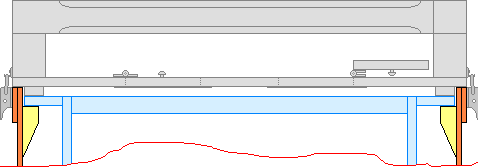
The lid is shown in grey and the frame is shown light blue in this diagram of the longitudinal cross section. The runners are 16 mm thick and are splayed in a very shallow fashion so that there is no step to obstruct bees when they are being bumped on the ground and then thrown into a hive... See
Hiving a Swarm.
The runners are set 18 mm down from the top of the box to ensure that the frame lugs are trapped and just nipped by the closing action of the toggle catches.
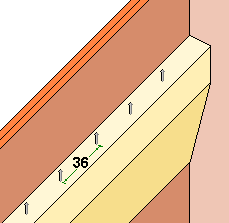
As the box will be used on occasions with single frames, or at least less than a full compliment of frames, we need to avoid the possibility of frames skewing and falling off the runners into the body of the box. For this I have used panel pins inserted into the top surface of the runners at 36 mm intervals. They should be knocked
in so that 6 or 7 mm is still showing, thus if a frame swings sideways it can only move a few mm before hitting a pin. This is another little trick that I have learned the hard way.
I have shown panel pins in the drawing, but the pegs that I have used myself have been 4 mm diameter beech dowels that have been rounded on the top and tapered at the bottom then driven into pilot holes with a dab of PVA glue.
The body of the box is made 240 mm deep inside (from rim to mesh) This allows for a clearance under any frames that are in the box at the time that a swarm is being collected. Otherwise the space under the frame may be blocked by bees and hinder others that are trying to enter the 'drawbridge'. The sides of the box are made from 5 mm ply and overlap the base by 9 mm. The ends are also made from 5 mm ply and overlap the base by 43 mm. The internal vertical corners of the box need to be stiffened by small slips of wood 10 mm - 12 mm in section (triangular fillet stock or quadrant beading are useful here).
Staples or No 4 woodscrews are used to fix the panels to the frame runners and the pre-fabricated base, using glue at all joints. While in use this type of box may be often bumped on the ground or be thumped with the heel of a hand, so use plenty of glue and do not be shy of putting in a few extra staples.
The 34 mm rim laminations are applied with glue and staples with the protruding tips of the staples turned over and hammered flat.
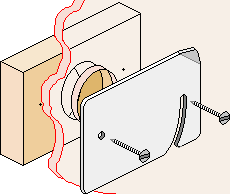
There are two types of entrance fitted, one on each end. The first of these is simply a 15 mm diameter hole with an aluminium plate that swivels on one screw and latches onto another. The screws will not bite adequately in the 5 mm ply and so a block of softwood is glued inside the box to accept the screws and
the entrance hole is bored through both the box front and the block. The box font is shown as a pink 'ghost' in the drawing at right.
The screws shown are slotted head, the type I chose for my boxes are the
'System Zero' type
which has a 'moulded in' washer as part of the design. The screws should be tight enough to stop free rotation and cause a slight drag on the curved slot.
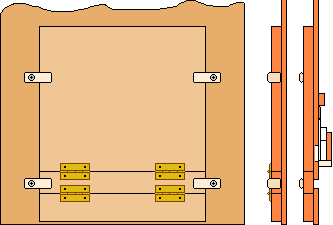
The other entrance is the most important part of the whole box. It is complex and care should be taken to work accurately. For durability and smooth operation the hinges are brass and are lubricated with
Petroleum Jelly.
Off cuts of piano hinge left over from the construction of a Marburg box are also ideal for this purpose.
The drawbridge is made in two parts, which are hinged together and are able to be held closed by wooden turnbuttons. The turnbuttons can be ideally made from Box, but this is not a commonly found wood in the beekeeper's scrap box.
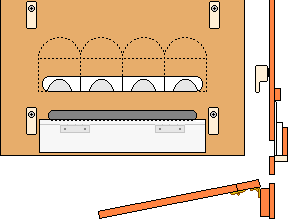
When both hinged portions of the drawbridge are secured, the box is totally bee tight and the slide should be removed from the base to enable adequate ventilation.
The drawing at right shows the broad slot that forms the main entrance. The drawbridge naturally forms a ramp that the bees will use for 'scenting'.
When the first hinged joint is folded up and secured by the turnbuttons the main entrance is closed off, but the overall appearance, from the bees point of view, is very much the same. Returning bees will use the row of truncated porter escapes to enter, but of course cannot leave.
The one way valve facility is made by cutting plastic porter escapes in half using a junior hacksaw, a blob of glue should be placed over the cut ends of the phosphor bronze springs as the sawing will weaken the grip of the plastic pegs.






